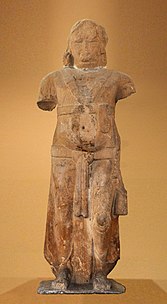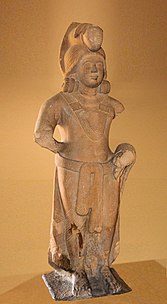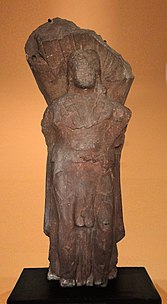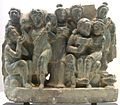Indo-Greek art
| Part of a series on the |
| Indo-Greek Kingdom |
|---|
 |
Indo-Greek artis the art of theIndo-Greeks,who reigned from circa 200 BC in areas ofBactriaand theIndian subcontinent.Initially, between 200 and 145 BC, they remained in control ofBactriawhile occupying areas of Indian subcontinent, until Bactria was lost to invading nomads. After 145 BC, Indo-Greek kings ruled exclusively in parts of ancient India, especially inGandhara,in what is now present-day the northwesternPakistan.The Indo-Greeks had a richHellenisticheritage and artistic proficiency as seen with the remains of the city ofAi-Khanoum,which was founded as aGreco-Bactriancity.[2]In modern-dayPakistan,several Indo-Greeks cities are known such asSirkapnearTaxila,Barikot,andSagalawhere some Indo-Greek artistic remains have been found, such asstone palettes.
Some Buddhist cultural objects related to the Indo-Greeks are known, such as theShinkot casket.By far the most important Indo-Greek remains found are numerous coins of the Indo-Greek kings, considered as some of the most artistically brilliant of Antiquity.[3]Most of the works of art of theGreco-Buddhist artofGandharaare usually attributed to the direct successors of the Indo-Greeks inAncient Indiain the 1st century AD, such as the nomadicIndo-Scythians,theIndo-Parthiansand, in an already decadent state, theKushans.[4]Many Gandharan works of art cannot be dated exactly, leaving the exact chronology open to interpretation. With the realization that the Indo-Greeks ruled in India until at least 10-20 AD with the reign ofStrato IIin thePunjab,the possibility of a direct connection between the Indo-Greeks andGreco-Buddhist arthas been reaffirmed recently.[5][6][7]
Early Indo-Bactrian period (200-145 BC)
[edit]The first Indo-Greek kings, also sometimes called "Indo-Bactrian", fromDemetrius I(200–190 BC) toEucratides(170–145 BC) ruled simultaneously,the areas of Bactria and northwestern India, until they were completely expelled from Bactria and the eastern Bactrian capital city ofAi-Khanoumby invading nomads, probably theYuezhi,or possibly theSakas,circa 145 BCE.[8][9][10]While Demetrius, the first Indo-Greek king, was extending his territory into India, still held Ai-Khanoum as one of his strongholds and continued to mint some of his coinage in the city.[11]The last Greek coinage in Ai-Khanoum was by Eucratides.[12]Because of their dual territorial possessions in Bactria and India, these kings, starting withDemetrius I,are variously described as Indo-Greek,[13]Indo-Bactrian,[14]or Greco-Bactrian.[15]After losing Bactria around circa 145 BCE during the rule of Eucratides andMenander I,the Greeks were generally called as "Indo-Greeks" only.
The main known remains from this period are the ruins and artifacts of their city ofAi-Khanoum,aGreco-Bactriancity founded circa 280 BC which continued to flourish during the first 55 years of the Indo-Greek period until its destruction by nomadic invaders in 145 BC, and their coinage, which is often bilingual, combiningGreekwith the IndianBrahmi scriptorKharoshthi.[16]Apart from Ai-Khanoum, Indo-Greek ruins have been positively identified in few cities such asBarikotorTaxila,with generally much fewer known artistic remains.[9][17]
Architecture in Bactria
[edit]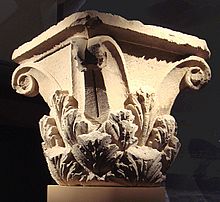
Numerous artefacts and structures were found, particularly in Ai-Khanoum, pointing to a high Hellenistic culture, combined with Eastern influences, starting from the 280-250 BC period.[18][19][20]Overall, Aï-Khanoum was an extremely important Greek city (1.5 sq kilometer), characteristic of theSeleucid Empireand then theGreco-Bactrian Kingdom,remaining one of the major cities at the time when the Greek kings started to occupy parts of India, from 200 to 145 BCE. It seems the city was destroyed, never to be rebuilt, about the time of the death of kingEucratidesaround 145 BC.[20]
Archaeological missions unearthed various structures, some of them perfectly Hellenistic, some other integrating elements of Persian architecture, including a citadel, a Classical theater, a huge palace in Greco-Bactrian architecture, somehow reminiscent of formal Persian palatial architecture, agymnasium(100 × 100m), one of the largest of Antiquity, various temples, a mosaic representing the Macedonian sun,acanthusleaves and various animals (crabs, dolphins etc...), numerous remains of ClassicalCorinthiancolumns.[20]Many artifacts are dated to the 2nd century BCE, which corresponds to the early Indo-Greek period.
-
Ai- Khanoum mosaic (central detail in color).
-
Architecturalantefixaewith Hellenistic "Flame palmette"design, Ai-Khanoum.
-
Sun dial within two sculpted lion feet.
-
Wingedantefix,a type only known from Ai-Khanoum.
Sculpture
[edit]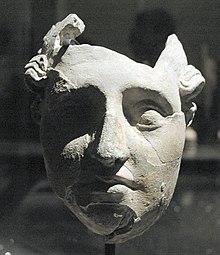
Various sculptural fragments were also found atAi-Khanoum,in a rather conventional, classical style, rather impervious to the Hellenizing innovations occurring at the same time in the Mediterranean world. Of special notice, a huge foot fragment in excellent Hellenistic style was recovered, which is estimated to have belonged to a 5-6 meter tall statue (which had to be seated to fit within the height of the columns supporting the Temple). Since the sandal of the foot fragment bears the symbolic depiction ofZeus'thunderbolt,the statue is thought to have been a smaller version of theStatue of Zeus at Olympia.[2][21]
Due to the lack of proper stones for sculptural work in the area of Ai-Khanoum, unbakedclayandstuccomodeled on a wooden frame were often used, a technique which would become widespread in Central Asia and the East, especially inBuddhist art.In some cases, only the hands and feet would be made in marble.
In India, only a few Hellenistic sculptural remains have been found, mainly small items in the excavations of Sirkap.
-
Sculpture of an old man. Ai-Khanoum, 2nd century BC.
-
Close-up of the same statue.
-
Frieze of a naked man wearing achlamys.Ai-Khanoum, 2nd century BC.
-
Hellenistic gargoyle. Ai-Khanoum, 2nd century BC.
Artefacts
[edit]
A variety of artefacts of Hellenistic style, often with Persian influence, were also excavated at Ai-Khanoum, such as a round medallion plate describing the goddessCybeleon a chariot, in front of a fire altar, and under a depiction ofHelios,a fully preserved bronze statue ofHerakles,various golden serpentine arm jewellery and earrings, a toilet tray representing a seatedAphrodite,a mold representing a bearded and diademed middle-aged man. Various artefacts of daily life are also clearly Hellenistic:sundials,ink wells, tableware. An almost life-sized dark green glassphalluswith a small owl on the back side and other treasures are said to have been discovered at Ai-Khanoum, possibly along with a stone with an inscription, which was not recovered. The artefacts have now been returned to theKabul Museumafter several years in Switzerland by Paul Bucherer-Dietschi, Director of the Swiss Afghanistan Institute.[22]
-
Bronze Herakles statuette. Ai-Khanoum. 2nd century BC.
-
Bracelet with horned female busts. Ai-Khanoum, 2nd century BC.
-
Stone recipients from Ai-Khanoum. 3rd-2nd century BC.
-
Imprint from a mold found in Ai-Khanoum. 3rd-2nd century BC.
First Indo-Greek coinage
[edit]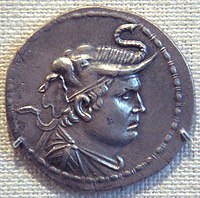
Demetrius I,the son ofEuthydemusis generally considered as the Greco-Bactrian king who first launched the Greek expansion intoAncient Indiacirca 190-180 BC, and is therefore the founder of theIndo-Greekrealm and the first recognized Indo-Greek king.[24][19]The first Indo-Greek kings, having dominions in Bactria as well as India, continued to strike coins in standardGreco-Bactrianstyle, but conjointly started to strike coins on the Indian standard having bilingual Indian-Greek legends.[16][2]
After the death of Demetrius, the Bactrian kingsPantaleonandAgathoclesstruck the first bilingual coins with Indian inscriptions found as far east as Taxila,[25]so in their time (c. 185–170 BC) the Bactrian kingdom seems to have included Gandhara.[26]These first bilingual coins used theBrahmi script,whereas later kings would generally useKharoshthi.They also went as far as incorporating Indian deities, variously interpreted as Hindu deities or theBuddha.[1][16]They also included various Indian devices (lion, elephant,zebubull) and symbols, some of them Buddhist such as the tree-in-railing.[27]These symbols can also be seen in thePost-Mauryan coinage of Gandhara.
The Hinduist coinage of Agathocles is few but spectacular. Six Indian-standard silverdrachmaswere discovered atAi-Khanoumin 1970, which depict Hindu deities.[16][28]These are earlyAvatarsofVishnu:Balarama-Sankarshanawith attributes consisting of theGadamace and theplow,andVasudeva-Krishnawith theVishnuattributes of theShankha(a pear-shaped case or conch) and theSudarshana Chakrawheel.[28]These first attempts at incorporating Indian culture were only partly preserved by later kings: they all continued to struck bilingual coins, sometimes in addition toAtticcoinage, but Greek deities remained prevalent. Indian animals however, such as the elephant, the bull or the lion, possibly with religious overtones, were used extensively in their Indian-standard square coinage. Buddhist wheels (Dharmachakras) still appear in the coinage ofMenander IandMenander II.[29][30]
In Ai-Khanoum, numerous coins were found, down toEucratides,but none of them later. Ai-Khanoum also yielded unique coins ofAgathocles,consisting of six Indian-standard silverdrachmsdepicting Hindu deities. These are the first known representations ofVedic deitieson coins, and they display earlyAvatarsofVishnu:Balarama-SamkarshanaandVasudeva-Krishna,and are thought to correspond to the first attempts at creating an Indian-standard coinage as they invaded northern India.[16]
| Territory/Ruler | Agathocles (190-180 BC) |
Pantaleon (190-180 BC) |
Apollodotus I (circa 180 BC) |
Eucratides (171-145 BCE) |
|---|---|---|---|---|
|
Bactria |
||||
|
India |
artefacts in Bactria
[edit]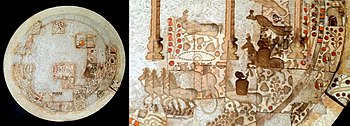
Ancient Indian artefacts were also found in the treasure room of the city, probably brought back by Eucratides from his Indian campaigns, which show a level of artistic interaction between Indian and the Greeks at that time. A narrative plate made of shell inlaid with various materials and colors, thought to represent the Indian myth ofShakuntalawas recovered.[31]Also, numerousIndian punch-marked coinswere found, about 677 of them in the Palace area of Ai-Khanoum alone, suggesting intense exchanges between Bactria and India.[16][32]
Greek cities in the subcontinent
[edit]The first Indo-Greek ruler Demetrius I is said to have built the city of Sirkap, in modern-day Pakistan.[33]The site of Sirkap was built according to a "Hippodamian"grid-plan characteristic of Greek cities.[34]It is organized around one main avenue and fifteen perpendicular streets, covering a surface of around 1,200 by 400 meters (3,900 ft × 1,300 ft), with a surrounding wall 5–7 meters (16–23 ft) wide and 4.8 kilometers (3.0 mi) long. The ruins are Greek in character, similar to those ofOlynthusinMacedonia.Numerous Hellenistic artifacts have been found, in particular coins of Greco-Bactrian kings and stone palettes representing Greek mythological scenes. Some of them are purely Hellenistic, others indicate an evolution of theGreco-Bactrianstyles found atAi-Khanoumtowards more indianized styles. For example, accessories such as Indian ankle bracelets can be found on some representations of Greek mythological figures such asArtemis.
-
Some remains at Sirkap.
-
Map of Sirkap excavations.
-
Sirkap at time of excavations.
-
Excavations at Sirkap.
Main Indian period (145 BC-20 AD)
[edit]The main Indian period of the Indo-Greeks starts with the reign ofMenander(from c. 165/155 BC) who has been described as the greatest of the Indo-Greek Kings.[35]
The remains of the Greeks inSouth Asiaessentially revolve around city ruins,stone palettes,a few Buddhist artefacts, and their abundant coinage.
Coinage
[edit]The Indo-Greek kings continued the tradition of minting bilingual coinage in India. Paradoxically, they were not as bold as earlier kings such asAgathoclesorPantaleonis showing Indian divinities. They all continued to struck bilingual coins, sometimes in addition toAtticcoinage, but Greek deities remained prevalent. Indian animals however, such as the elephant, the bull or the lion, possibly with religious overtones, were used extensively in their Indian-standard square coinage. Buddhist wheels (Dharmachakras) appear in the coinage ofMenander IandMenander II.[29][30]
-
Famous Indian-standard coinage of Menander I withwheel design.
-
Coin ofAntialcidas(105–95 BC), with elephant accompanying Zeus
-
Coin ofMenander II(90–85 BC), with seated Zeus and Nike on his arm, extending a victory wreath over a wheel symbol
-
Coin ofStrato II(25 BC-10 AD), one of the last Indo-Greek kings.
Architecture
[edit]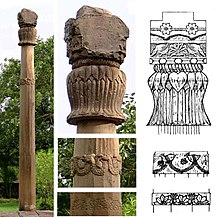
Besides the amin city ofSirkap,founded by Demetrius I, an expeditions in the 1980s and 90s discovered an Indo-Greek town inBarikotfrom around the time of KingMenander Iin the 2nd century BC. The 2nd century BC town covered, at its peak, an area of about 10 ha (25 acres) including theacropolis,or about 7 ha (17 acres) without. It was surrounded by a defensive wall about 2.7 meters thick with massive rectangularbastionsand a moat, and was structurally similar to other Hellenistic fortified cities such asAi-KhanoumorSirkap.[38][39]Indo-Greek coins were found, especially in the layers associated with the wall's construction, as well as potsherds with Greek letters.[38]
The Indo-Greeks are also known for their involvement in the construction of a few architectural elements. In 115 BC, that the embassy ofHeliodorus,from kingAntialkidasto the court of theSungaskingBhagabhadrainVidisha,is recorded. In the Sunga capital, Heliodorus established theHeliodorus pillarin a dedication toVāsudeva.This would indicate that relations between the Indo-Greeks and the Sungas had improved by that time, that people traveled between the two realms, and also that the Indo-Greeks readily followed Indian religions.[40]
A coin of Menander I was found in the second oldest stratum (GSt 2) of theButkara stupasuggesting a period of additional constructions during the reign of Menander.[41]It is thought that Menander was the builder of the second oldest layer of the Butkara stupa, following its initial construction during theMaurya empire.[42]These elements tend to indicate the importance of Buddhism within Greek communities in northwestern India, and the prominent role Greek Buddhist monks played in them, probably under the sponsorship of Menander.
-
Ruins of the city of Barikot
-
Ruins of the Indo-Greek city ofBarikot
-
TheButkara stupaas expanded during the reign of Menander I.
Indo-Greek artefacts in India
[edit]Few artefacts are known with certainty to belong to the Indo-Greeks. TheShinkot casket,a Buddhist relic casket was dedicated during the reign ofMenander I,bearing his name in an inscription.[44]
Stone palettes (circa 100 BC)
[edit]
Stone palette,also called "toilet tray" or "cosmetic trays" ) is a round tray commonly found in the areas ofBactriaandGandhara,and which usually representGreek mythologicalscenes. Some of them are attributed to theIndo-Greekperiod in the 2nd and 1st centuryBC.A few were retrieved from the Indo-Greek stratum No.5 atSirkap.Some stone palettes with some very pure Hellenistic designs are thought to date to circa 100 BC, and to have come fromTaxila.[46]Other have mythological themes, such as theRape of Europa,which "could have only been made by a Greek patron during the Indo-Greek period".[47]
Intaglio gems
[edit]
Intaglio gems from northwest India, showing an evolution from Greek workmanship to more degraded forms, range from circa 2nd century BC to 2nd century AD.[48]
Inscriptions and sculptures
[edit]Some inscriptions remain mentioning Indo-Greek rule, such as theYavanarajya inscription,mentioned the rule of the Indo-Greeks inMathurafrom the reign of Menander I to the period circa 50 BC.[49]Stone art and architecture began being produced at Mathura at the time of Indo-Greek hegemony over the region.[50]Some authors consider that Indo-Greek cultural elements are not particularly visible in theart of Mathura,and Hellenistic influence is not more important than in other parts of India.[51]Others consider thatHellenistic influenceappears in the liveliness and the realistic details of the figures (an evolution compared to the stiffness ofMauryan art), the use of perspective from 150 BC, iconographical details such as the knot and the club ofHeracles,the wavy folds of the dresses, or the depiction ofbacchanalianscenes.[50][52]The art of Mathura became extremely influential over the rest of India, and was "the most prominent artistic production center from the second century BC".[50]
Excavation atSemthanin southernKashmirhave revealed a Greek settlement.[53]Many figurines in theHellenistic stylewere found during the excavations.[54]The female figurines are fully dressed, with the left leg slightly bent, and wear the Greekchitonandhimation,and the Hellenistic styles ofBactriaare probably the ultimate source of these designs.[54][55]It is thought that the Indo-Greeks introduced their artistic styles into the area as they moved eastward from the area of Gandhara into South Kashmir.[56]
Such Hellenistic draped figurines have not been found atTaxilaorCharsadda,although they are known to have been Greek cities, but probably this is mainly because excavations to Greek levels have been very limited: in Sirkap, only one eight of the excavations were made down to the Indo-Greek and early Saka levels, and only in an area far removed from the center of the ancient city, where few finds could be expected.[57]
-
Terracotta statuette in Chiton and Himation,Semthan,Southern Kashmir
-
Male Hellenistic dress, Semthan
-
Semthan, female Hellenistic dresses
Buddhist reliquaries
[edit]According toHarry FalkBuddhist stone reliquaries, which were generally place insided stupas with precious relics of the Buddha or other saints, are directly derived from the stonepyxiswhich have been excavated atAi-Khanoumand originated in the west.[58]The Ai-Khanoum stone containers are thought to have played a religious role, and were apparently used to burnincense.[58]The shapes, material, and decoration are very similar to the later Buddhist containers, down to the compartmentalization inside the containers themselves.[58]One such containers theShinkot casket,is a Buddhist relics container which was engraved with the name of the Indo-Greek kingMenander I.[44][60]
The Bimaran reliquary, with one of the earliest known images of the Buddha, is generally dated to a period corresponding the end of Indo-Greek rule circa 1-15 CE, but was actually deposited by one of theIndo-Scythiansuccessors of the Indo-Greeks, namesKharahostes.[61]The Bimaran casket already displays a combination of Hellenistic design elements with Indian ones, such as the arches and the lotus design.[62]
-
TheShinkot casket,a Buddhist relics container in the name ofMenander I
-
TheBimaran reliquaryis often dated to circa 1-15 CE, at the time of the last Indo-Greek kings.
Architecture and statuary under the Indo-Greeks in Mathura (180-70 BCE)
[edit]Architecture
[edit]From time of theMauryan Empire,India was able to use as an example the architectural work of theGreco-Bactriansand theIndo-Greeksfrom the 3rd to the 1st centuries BC, with influences which are clearly visible in the Hellenistic designs, such asflame palmettes,beads and reelsused and adapted from that time in Indian art.[64]
Stone statuary
[edit]150-100 BCE
Following the demise of the Mauryan Empire and its replacement by theSunga Empirein eastern India, numismatic, literary and epigraphic evidence suggest that theIndo-Greeks,when they invaded India, occupied the area of Mathura for close to a century from circa 180 BCE and the time ofMenander Iuntil approximately 70 BCE, with the Sungas remaining eastward of Mathura.[72][50]An inscription in Mathura discovered in 1988,[73][74]the "Yavanarajya inscription",mentions" The last day of year 116 of Yavana hegemony (Yavanarajya) ", suggesting the presence of the Indo-Greeks in the 2nd-1st century BC in Mathura down to 70 or 69 BC.[72]On the contrary, theSungas,are thought to have been absent from Mathura, as no epigraphical remains or coins have been found, and to have been based to the east of the Mathura region.[72]
Stone art and architecture began being produced at Mathura at the time of "Indo-Greek hegemony" over the region.[75][50]Some authors consider that Indo-Greek cultural elements are not particularly visible in these works, and Hellenistic influence is not more important than in other parts of India.[51]Others consider thatHellenistic influenceappears in the liveliness and the realistic details of the figures (an evolution compared to the stiffness ofMauryan art), the use of perspective from 150 BCE, iconographical details such as the knot and the club ofHeracles,the wavy folds of the dresses, or the depiction ofbacchanalianscenes:[50][52]
"Mathura sculpture is distinguished by several qualitative features of art, culture and religious history. The geographical position of the city on the highway leading from the Madhyadesa towards Madra-Gandhara contributed in a large measure to the eclectic nature of its culture. Mathura became the meeting ground of the traditions of the early Indian art ofBharhutandSanchitogether with strong influences of theIranianand the Indo-Bactrian or theGandhara artfrom the North-West. The Persepolitan capitals with human-headed animal figures and volutes as well as the presence of the battlement motif as a decorative element point to Iranian affinities. These influences came partly as a result of the general saturation of foreign motifs in early Indian sculpture as found in theStupasofBharhutandSanchialso. "
— Vasudeva Shrarana Agrawala,Masterpieces of Mathura sculpture[76]
The art of Mathura became extremely influential over the rest of India, and was "the most prominent artistic production center from the second century BCE".[50]
Colossal anthropomorphic statues (2nd century BC)
[edit]Yakshasseems to have been the object of an important cult in the early periods of Indian history, many of them being known such asKubera,king of the Yakshas,ManibhadraorMudgarpani.[77]The Yakshas are a broad class of nature-spirits, usually benevolent, but sometimes mischievous or capricious, connected with water, fertility, trees, the forest, treasure and wilderness,[78][79]and were the object of popular worship.[80]Many of them were later incorporated into Buddhism, Jainism or Hinduism.[77]
In the 2nd century BCE, Yakshas became the focus of the creation of colossal cultic images, typically around 2 meters or more in height, which are considered as probably the first Indian anthropomorphic productions in stone.[52][77]Although few ancient Yaksha statues remains in good condition, the vigor of the style has been applauded, and expresses essentially Indian qualities.[52]They are often pot-bellied, two-armed and fierce-looking.[77]The Yashas are often depicted with weapons or attributes, such as the YakshaMudgarpaniwho in the right hand holds amudgarmace, and in the left hand the figure of a small standing devotee or child joining hands in prayer.[66][77]It is often suggested that the style of the colossal Yaksha statuary had an important influence on the creation of later divine images and human figures in India.[81]The female equivalent of the Yashas were theYashinis,often associated with trees and children, and whose voluptuous figures became omnipresent in Indian art.[77]
SomeHellenisticinfluence, such as the geometrical folds of the drapery or the walking stance of the statues, has been suggested.[52]According toJohn Boardman,the hem of the dress in the monumental early Yaksha statues is derived from Greek art.[52]Describing the drapery of one of these statues, John Boardman writes: "It has no local antecedents and looks most like a Greek Late Archaic mannerism", and suggests it is possibly derived from theHellenistic artof nearbyBactriawhere this design is known.[52]
In the production of colossal Yaksha statues carved in the round, which can be found in several locations in northern India, theart of Mathurais considered as the most advanced in quality and quantity during this period.[82]ColossalNāgastatues are also known from this period in Mathura, also denoting an early cult of this deity.[83]
Incipient Greco-Buddhist art
[edit]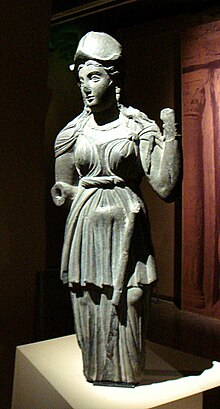
The possibility of a direct connection between the Indo-Greeks and Greco-Buddhist art has been reaffirmed recently as the dating of the rule of Indo-Greek kings has been extended to the first decades of the 1st century AD, with the reign ofStrato IIin the Punjab.[84]Also, Foucher, Tarn and more recently Boardman, Bussagli or McEvilley have taken the view that some of the most purely Hellenistic works of northwestern India, Pakistan and Afghanistan, may actually be wrongly attributed to later centuries, and instead belong to a period one or two centuries earlier, to the time of the Indo-Greeks in the 2nd-1st century BC:[85]
This is particularly the case of some purely Hellenistic works inHadda, Afghanistan,an area which "might indeed be the cradle of incipient Buddhist sculpture in Indo-Greek style".[86]Referring to one of the Buddha triads in Hadda (drawing), in which the Buddha is sided by very Classical depictions ofHerakles/VajrapaniandTyche/Hariti,Boardman explains that both figures "might at first (and even second) glance, pass as, say, from Asia Minor or Syria of the first or second century BC (...) these are essentially Greek figures, executed by artists fully conversant with far more than the externals of the Classical style".[87]Many of the works of art at Hadda can also be compared to the style of the 2nd century BC sculptures of the Hellenistic world, such as those of theTemple of Olympia at Bassaein Greece, which could also suggest roughly contemporary dates.[citation needed]
Alternatively, it has been suggested that these works of art may have been executed by itinerant Greek artists during the time of maritime contacts with the West from the 1st to the 3rd century AD.[88]
The supposition that such highly Hellenistic and, at the same time Buddhist, works of art belong to the Indo-Greek period would be consistent with the known Buddhist activity of the Indo-Greeks (theMilinda Panhaetc...), their Hellenistic cultural heritage which would naturally have induced them to produce extensive statuary, their know artistic proficiency as seen on their coins until around 50 BCE, and the dated appearance of already complex iconography incorporating Hellenistic sculptural codes with theBimaran casketin the early 1st century AD.[citation needed]
Greek-looking people in the art of Gandhara
[edit]
TheGreco-Buddhist artofGandhara,beyond the omnipresence of Greek style and stylistic elements which might be simply considered as an enduring artistic tradition,[89]offers numerous depictions of people in GreekClassicalrealistic style,attitudesand fashion (clothes such as thechitonand thehimation,similar in form and style to the 2nd century BCEGreco-Bactrianstatues ofAi-Khanoum,hairstyle), holding contraptions which are characteristic of Greek culture (amphoras,"kantaros" Greek drinking cups), in situations which can range from festive (such asBacchanalianscenes) to Buddhist-devotional.[90][91]
Uncertainties in dating make it unclear whether these works of art actually depict Greeks of the period of Indo-Greek rule up to the 1st century BCE, or remaining Greek communities under the rule of theIndo-ParthiansorKushansin the 1st and 2nd century CE.
Hellenistic groups
[edit]
A series of reliefs, several of them known as theBuner reliefswhich were taken during the 19th century from Buddhist structures near the area of Buner in northernPakistan,depict in perfect Hellenistic style gatherings of people in Greek dress, socializing, drinking or playing music.[92]They have been called "Proto-Gandharan",[55]and are considered to be "slightly later" then the earliest stone palettes, themselves dated to circa 100 BCE.[55][46]Some other of these reliefs depictIndo-Scythiansoldiers in uniform, sometimes playing instruments.[93]Finally, revelling Indian indhotisrichly adorned with jewelry are also shown. These are considered some of the most artistically perfect, and earliest, of Gandharan sculptures, and are thought to exalt multicultural interaction within the context of Buddhism,[citation needed]in the 1st century BCE or the 1st century CE.
-
Hellenistic drinking scene.
-
Hellenistic marine deities, Gandhara, 1st century.
-
Hellenistic drinking scene, Sar Khi Derri.
-
TheTrojan Horse.
Bacchic scenes
[edit]Greeks harvesting grapes, Greeks drinking and revelling, scenes of erotical courtship are also numerous, and seem to relate to some of the most remarkable traits of Greek culture.[94]These reliefs also belong to Buddhist structures, and it is sometimes suggested that they might represent some kind of paradisical world after death.
-
Bacchanalian scene, representing the harvest of wine grapes, Greco-Buddhist art of Gandhara, 1st-2nd century CE.
-
Indo-Greek bacchanalian scene, 1st-2nd century.
-
Satyron a mountain goat, drinking with women. Gandhara, 2nd-4th century.
-
Musician wearing thechitondress.
-
Bacchanalian scene, Gandhara.
Hellenistic devotees
[edit]
Depictions of people in Hellenistic dress within a Buddhist context are also numerous.[95]Some show a Greek devotee couple circumambulating stupas together with shaven monks, others Greek protagonists are incorporated in Buddhistjatakastories of the life of the Buddha (relief of The Great Departure), others are simply depicted as devotees on the columns of Buddhist structures. A few famous friezes, including one in the British Museum, also depict the story of theTrojan horse.It is unclear whether these reliefs actually depict contemporary Greek devotees in the area of Gandhara, or if they are just part of a remaining artistic tradition. Most of these reliefs are usually dated to the 1st-3rd century CE.
-
Couple of devotees in Hellenistichimationdress, at the base of a Buddha statue.
-
Devotee in Greek dress, on a Buddhist pilaster.Chakhil-i-Ghoundi Stupa.
-
"The Great Departure", with the Buddha amid Greek deities and costumes.
-
Hellenistic man or God, Gandhara.
-
Indo-Corinthian capitalrepresenting a Buddhist devotee wearing a Greek cloak (chlamys) attached by afibula.Dated to the 1st century BCE.Butkara Stupa.
-
Aristocratic women, Gandhara.
Contributions by "Yavanas" in the 1st-2nd centuries AD
[edit]
After formal Greek political power waned circa 10 AD, some Greek nuclei may have continued to survive until the 2nd century AD.[97]
Tapa Shotor
[edit]According to archaeologistRaymond Allchin,the site ofTapa ShotornearHaddasuggests that theGreco-Buddhist artofGandharadescended directly from the art of HellenisticBactria,as seen inAi-Khanoum.[98]ArchaeologistZemaryalai Tarzihas suggested that, following the fall of theGreco-Bactriancities ofAi-KhanoumandTakht-i Sangin,Greek populations were established in the plains ofJalalabad,which includedHadda,around the Hellenistic city ofDionysopolis,and that they were responsible for the Hellenistic Buddhist creations ofTapa Shotorin the 2nd century AD.[96]
Buddhist caves
[edit]A large number ofBuddhist caves in India,particularly in the west of the country, were artistically hewn between the 1st century BC and the 2nd century AD. Numerous donors provided the funds for the building of these caves and left donatory inscriptions, including laity, members of the clergy, government officials. Foreigners, mostly self-declaredYavanas,represented about 8% of all inscriptions.[99]
Karla Caves
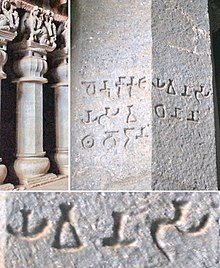



 ,circa AD 120.
,circa AD 120.Yavanas from the region ofNashikare mentioned as donors for six structural pillars in the Great BuddhistChaityaof theKarla Cavesbuilt and dedicated byWestern SatrapsrulerNahapanain 120 CE,[101]although they seem to have adopted Buddhist names.[102]In total, the Yavanas account for nearly half of the known dedicatory inscriptions on the pillars of the Great Chaitya.[103]To this day, Nasik is known as thewinecapital of India, using grapes that were probably originally imported by the Greeks.[104]
Shivneri Caves
Two more Buddhist inscriptions by Yavanas were found in theShivneri Caves.[105]One of the inscriptions mentions the donation of a tank by the Yavana named Irila, while the other mentions the gift of a refectory to theSanghaby the Yavana named Cita.[105]On this second inscription, the Buddhist symbols of thetriratnaand of theswastika(reversed) are positioned on both sides of the first word "Yavana(sa)".
Pandavleni Caves

One of the Buddhist caves (Cave No.17) in thePandavleni Cavescomplex nearNashikwas built and dedicated by "Indragnidatta the son of theYavanaDharmadeva, a northerner from Dattamittri ", in the 2nd century AD.[106][107][108]The city of "Dattamittri" is thought to be the city ofDemetriasinArachosia,mentioned byIsidore of Charax.[106]
Manmodi Caves
In theManmodi Caves,nearJunnar,an inscription by aYavanadonor appears on the façade of the mainChaitya,on the central flat surface of the lotus over the entrance: it mentions the erection of the hall-front (façade) for the Buddhist Samgha, by a Yavana donor named Chanda:[109]
"yavanasa camdānam gabhadā[ra]"
"The meritorious gift of thefaçadeof the (gharba) hall by theYavanaChanda "
These contributions seem to have ended when theSatavahanaKingGautamiputra Satakarniclaimed to have vanquished a confederacy ofYavanas(Indo-Greeks),Shakas(Western Kshatrapas),Pahlavas(Indo-Parthians) under theWestern SatraprulerNahapanacirca 130 CE. This victory is known from the fact that Gautamiputra Satakarni restruck many of Nahapana's coins, and that he is claimed to have defeated the Yavanas and their confederates in the inscription of his mother Queen Gotami Balasiri at Cave No. 3 of theNasik Caves:[113][114]
...Siri-Satakani Gotamiputa(....) who crushed down the pride and conceit of theKshatriyas;who destroyed theSakas,YavanasandPalhavas;who rooted out theKhakharatarace; who restored the glory of theSatavahanafamily...
See also
[edit]- Greco-Bactrian Kingdom
- Seleucid Empire
- Greco-Buddhism
- Indo-Scythian art
- Indo-Parthian Kingdom
- Kushan art
- Roman commerce
- Timeline of Indo-Greek Kingdoms
Notes
[edit]- ^abHolt, Frank Lee (1988).Alexander the Great and Bactria: The Formation of a Greek Frontier in Central Asia.Brill Archive.ISBN9004086129.
- ^abcThapar, Romila (2004).Early India: From the Origins to AD 1300.University of California Press. pp. 215–216.ISBN9780520242258.
- ^"The extraordinary realism of their portraiture. The portraits of Demetrius, Antimachus and of Eucratides are among the most remarkable that have come down to us from antiquity" Hellenism in ancient India, Banerjee, p134
- ^"Just as theFrankClovishad no part in the development ofGallo-Roman art,the Indo-Scythian Kanishka had no direct influence on that of Indo-Greek Art; and besides, we have now the certain proofs that during his reign this art was already stereotyped, if not decadent "Hellenism in Ancient India, Banerjee, p147
- ^"The survival into the first century AD of a Greek administration and presumably some elements of Greek culture in thePunjabhas now to be taken into account in any discussion of the role of Greek influence in the development of Gandharan sculpture ", inCribb, Joe; Bopearachchi, Osmund (1992).The Crossroads of Asia: transformation in image and symbol in the art of ancient Afghanistan and Pakistan.Cambridge: Fitzwilliam Museum, Ancient India and Iran Trust. p. 14.ISBN9780951839911.
- ^"Following discoveries at Ai-Khanum, in modern-dayAfghanistanexcavations atTapa Shotor,Hadda, produced evidence to indicate that Gandharan art descended directly from Hellenised Bactrian art. "inAllchin, Frank Raymond (1997).Gandharan Art in Context: East-west Exchanges at the Crossroads of Asia.Published for the Ancient India and Iran Trust, Cambridge by Regency Publications. p. 19.ISBN9788186030486.
- ^"We have to look for the beginnings of Gandharan Buddhist art both in the residual Indo-Greek tradition, and in the early Buddhist stone sculpture to the South (Bharhut etc...)" inBoardman, John (1994).The Diffusion of Classical Art in Antiquity.Princeton University Press. p. 124.ISBN9780691036809.
- ^"Bopearachchiattributes the destruction of Ai Khanoum to the Yuezhi, rather than to the alternative 'conquerors' and destroyers of the last vestiges of Greek power in Bactria, the Sakas... "Benjamin, Craig (2007).The Yuezhi: Origin, Migration and the Conquest of Northern Bactria.Isd. p. 180.ISBN9782503524290.
- ^abSingh, Upinder (2008).A History of Ancient and Early Medieval India: From the Stone Age to the 12th Century.Pearson Education India. p. 373.ISBN9788131716779.
- ^Holt, Frank Lee (1999).Thundering Zeus: the making of Hellenistic Bactria.University of California Press. pp. 135–136.ISBN9780520920095.
- ^Joseph, Frances A.M. (2016).Conflict in Ancient Greece and Rome: The Definitive Political, Social, and Military Encyclopedia [3 volumes]: The Definitive Political, Social, and Military Encyclopedia.ABC-CLIO. pp. 239–240.ISBN9781610690201.
- ^Cohen, Getzel M. (2013).The Hellenistic Settlements in the East from Armenia and Mesopotamia to Bactria and India.University of California Press. p. 242.ISBN9780520953567.
- ^Gyselen, Rika (2007).Des Indo-Grecs aux Sassanides: données pour l'histoire et la géographie historique.Peeters Publishers. p. 104.ISBN9782952137614.
- ^Yarshater, Ehsan (1983).The Cambridge History of Iran.Cambridge University Press. p. 190.ISBN9780521200929.
- ^Baumer, Christoph (2012).The History of Central Asia: The Age of the Steppe Warriors.I.B.Tauris. p. 289.ISBN9781780760605.
- ^abcdefSingh, Upinder (2008).A History of Ancient and Early Medieval India: From the Stone Age to the 12th Century.Pearson Education India. p. 374.ISBN9788131716779.
- ^Behrendt, Kurt A. (2007).The Art of Gandhara in the Metropolitan Museum of Art.Metropolitan Museum of Art. p. 7.ISBN9781588392244.
- ^"It has all the hallmarks of a Hellenistic city, with a Greek theatre, gymnasium and some Greek houses with colonnaded courtyards" (Boardman).
- ^abSingh, Upinder (2008).A History of Ancient and Early Medieval India: From the Stone Age to the 12th Century.Pearson Education India. p. 375.ISBN9788131716779.
- ^abcHolt, Frank Lee (1999).Thundering Zeus: The Making of Hellenistic Bactria.University of California Press. pp. 43–44.ISBN9780520920095.
- ^Bernard, Paul (1967)."Deuxième campagne de fouilles d'Aï Khanoum en Bactriane".Comptes rendus des séances de l'Académie des Inscriptions et Belles-Lettres.111(2): 306–324.doi:10.3406/crai.1967.12124.
- ^Source, BBC News,Another article.German story with photographshere(translationhere).
- ^Demetrius is said to have foundedTaxila(archaeological excavations), and alsoSagalain the modern-dayPakistan,which he seemed to have called Euthydemia, after his father ( "the city of Sagala, also called Euthydemia" (Ptolemy, Geographia, VII 1))
- ^A Journey Through India's Past Chandra Mauli Mani, Northern Book Centre, 2005, p. 39
- ^MacDowall, 2004
- ^"The only thing that seems reasonably sure is that Taxila was part of the domain of Agathocles", Bopearachchi,Monnaies,p. 59
- ^Krishan, Yuvraj; Tadikonda, Kalpana K. (1996).The Buddha Image: Its Origin and Development.Bharatiya Vidya Bhavan. p. 22.ISBN9788121505659.
- ^abIconography of Balarāma, Nilakanth Purushottam Joshi, Abhinav Publications, 1979, p. 22[1]
- ^abStanton, Andrea L.; Ramsamy, Edward; Seybolt, Peter J.; Elliott, Carolyn M. (2012).Cultural Sociology of the Middle East, Asia, and Africa: An Encyclopedia.SAGE Publications. p. 28.ISBN9781452266626.
- ^abSingh, Nagendra Kr; Mishra, A. P. (2007).Encyclopaedia of Oriental Philosophy and Religion: Buddhism.Global Vision Publishing House. pp. 351, 608–609.ISBN9788182201156.
- ^"Afghanistan, tresors retrouves", p150
- ^Joe Cribb, Investigating the introduction of coinage in India, Journal of the Numismatic Society of India xlv Varanasi 1983 pp.89
- ^Ghosh, Amalananda (1965).Taxila.CUP Archive. p. 763.
- ^McNicoll, Anthony; Milner, N. P. (1997).Hellenistic Fortifications from the Aegean to the Euphrates.Clarendon Press. p. 102.ISBN9780198132288.
- ^"Menander".Encyclopædia Britannica Online.Encyclopædia Britannica, Inc.Retrieved7 August2015.
Menander, also spelled Minedra or Menadra, Pali Milinda (flourished 160 BCE?–135 BCE?), the greatest of the Indo-Greek kings and the one best known to Western and Indian classical authors. He is believed to have been a patron of the Buddhist religion and the subject of an important Buddhist work, the Milinda-panha ( "The Questions of Milinda" ). Menander was born in the Caucasus, but the Greek biographer Plutarch calls him a king of Bactria, and the Greek geographer and historian Strabo includes him among the Bactrian Greeks "who conquered more tribes than Alexander [the Great]."
- ^Osmund Bopearachchi,2016,Emergence of Viṣṇu and Śiva Images in India: Numismatic and Sculptural Evidence
- ^Hermann KulkeandDietmar Rothermund(2004).A History of India.Routledge. p. 73.ISBN978-0-415-32920-0.
- ^abGallieri, Pier Francesco (2007).On the Cusp of an Era: Art in the Pre-Kuṣāṇa World.BRILL. pp. 140–150.ISBN9789004154513.
- ^Khaliq, Fazal (24 May 2015)."Swat's archaeological sites: a victim of neglect".DAWN.COM.Retrieved2017-09-13.
- ^Ancient Indian History and Civilization, Sailendra Nath Sen, New Age International, 1999p. 170
- ^Handbuch der Orientalistik, Kurt A. Behrendt, BRILL, 2004, p.49 sig
- ^"King Menander, who built the penultimate layer of the Butkara stupa in the first century BC, was an Indo-Greek."Empires of the Indus: The Story of a River,Alice Albinia,2012
- ^Avari, Burjor (2016).India: The Ancient Past: A History of the Indian Subcontinent from C. 7000 BC to AD 1200.Routledge. p. 167.ISBN9781317236733.
- ^abBaums, Stefan (2017).A framework for Gandharan chronology based on relic inscriptions, in "Problems of Chronology in Gandharan Art".Archaeopress.
- ^Marshall, John (1951).Taxila vol.III.p. Plaque 144.
- ^abSiudmak, John (2013).The Hindu-Buddhist Sculpture of Ancient Kashmir and its Influences.BRILL. pp. 58–59.ISBN978-90-04-24832-8.
- ^Siudmak, John (2013).The Hindu-Buddhist Sculpture of Ancient Kashmir and its Influences.BRILL. p. 57 note 65.ISBN978-90-04-24832-8.
- ^Rapson, Edward James (1922).The Cambridge history of India.Cambridge University Press.
- ^History of Early Stone Sculpture at Mathura: Ca. 150 BC - 100 AD, Sonya Rhie Quintanilla, BRILL, 2007pp. 254-255
- ^abcdefgStoneman, Richard (2019).The Greek Experience of India: From Alexander to the Indo-Greeks.Princeton University Press. pp. 436–437.ISBN9780691185385.
- ^abQuintanilla, Sonya Rhie (2007).History of Early Stone Sculpture at Mathura: Ca. 150 BCE - 100 CE.BRILL. p. 10.ISBN9789004155374.
- ^abcdefgBoardman, John (1993).The Diffusion of Classical Art in Antiquity.Princeton University Press. p. 112.ISBN0691036802.
- ^Jamwal, Suman (1994). "Commercial Contacts Between Kashmir and Rome".Annals of the Bhandarkar Oriental Research Institute.75(1/4): 202.ISSN0378-1143.JSTOR41694416.
- ^abSiudmak, John (2013).The Hindu-Buddhist Sculpture of Ancient Kashmir and its Influences.BRILL. pp. 32–36.ISBN978-90-04-24832-8.
- ^abcSiudmak, John (2013).The Hindu-Buddhist Sculpture of Ancient Kashmir and its Influences.BRILL. p. 43.ISBN978-90-04-24832-8.
- ^Kaw, Mushtaq A. (2010). "Central Asian Contribution to Kashmir's Tradition of Religio-Cultural Pluralism".Central Asiatic Journal.54(2): 245.ISSN0008-9192.JSTOR41928559.
- ^Siudmak, John (2013).The Hindu-Buddhist Sculpture of Ancient Kashmir and its Influences.BRILL. pp. 39–43.ISBN978-90-04-24832-8.
- ^abcdFalk, Harry (2015).Buddhistische Reliquienbehälter aus der Sammlung Gritli von Mitterwallner.pp. 134–135.
- ^Salomon, Richard (2005).A New Inscription dated in the "Yona" (Greek) Era of 186/5 B.C.Brepols. pp. 359–400.ISBN978-2-503-51681-3.
- ^Chakravarti, N. P (1937).Epigraphia Indica Vol.24.pp.1–10.
- ^Fussman, 1986, p.71, quoted in The Crossroads of Asia, p.192
- ^The Cambridge History of India.CUP Archive. 1922. pp.646–647.
- ^Quintanilla, Sonya Rhie (2007).History of Early Stone Sculpture at Mathura: Ca. 150 BCE - 100 CE.BRILL. p. 132 Note 57.ISBN9789004155374.
- ^BOARDMAN, JOHN (1998). "Reflections on the Origins of Indian Stone Architecture".Bulletin of the Asia Institute.12:13–22.ISSN0890-4464.JSTOR24049089.
- ^Quintanilla, Sonya Rhie (2007).History of Early Stone Sculpture at Mathura: Ca. 150 BCE - 100 CE.BRILL. p. 368, Fig. 88.ISBN9789004155374.
- ^abFig. 85 inQuintanilla, Sonya Rhie (2007).History of Early Stone Sculpture at Mathura: Ca. 150 BCE - 100 CE.BRILL. p. Fig.85, p.365.ISBN9789004155374.
- ^Dalal, Roshen (2010).The Religions of India: A Concise Guide to Nine Major Faiths.Penguin Books India. p. 398.ISBN978-0-14-341517-6.
- ^abDated 100 BCE in Fig. 86-87, page 365-368 inQuintanilla, Sonya Rhie (2007).History of Early Stone Sculpture at Mathura: Ca. 150 BCE - 100 CE.BRILL. p. Fig.85, p.365.ISBN9789004155374.
- ^abDated 150 BCE in Fig. 20, page 33-35 inQuintanilla, Sonya Rhie (2007).History of Early Stone Sculpture at Mathura: Ca. 150 BCE - 100 CE.BRILL. p. Fig.85, p.365.ISBN9789004155374.
- ^Dated 150 BCE in Fig. 15-17, general comments p.26-27 inQuintanilla, Sonya Rhie (2007).History of Early Stone Sculpture at Mathura: Ca. 150 BCE - 100 CE.BRILL.ISBN9789004155374.
- ^Dated 100 BCE in Fig.88 inQuintanilla, Sonya Rhie (2007).History of Early Stone Sculpture at Mathura: Ca. 150 BCE - 100 CE.BRILL. p. 368, Fig. 88.ISBN9789004155374.
- ^abcQuintanilla, Sonya Rhie (2007).History of Early Stone Sculpture at Mathura: Ca. 150 BCE - 100 CE.BRILL. pp. 8–10.ISBN978-90-04-15537-4.
- ^Published in "L'Indo-Grec Menandre ou Paul Demieville revisite," Journal Asiatique 281 (1993) p.113
- ^"Some Newly Discovered Inscriptions from Mathura: The Meghera Well Stone Inscription of Yavanarajya Year 160 Recently a stone inscription was acquired in the Government Museum, Mathura." India's ancient past, Shankar Goyal Book Enclave, 2004, p.189
- ^"During the time of Indo-Greek hegemony, art and architecture in the medium of stone began to be produced in the Mathura region" inQuintanilla, Sonya Rhie (2007).History of Early Stone Sculpture at Mathura: Ca. 150 BCE - 100 CE.BRILL. p. 10.ISBN978-90-04-15537-4.
- ^Agrawala, Vasudeva S. (1965).Masterpieces of Mathura sculpture.p. 3.
- ^abcdefDalal, Roshen (2010).The Religions of India: A Concise Guide to Nine Major Faiths.Penguin Books India. pp. 397–398.ISBN978-0-14-341517-6.
- ^Singh, Upinder (2008).A History of Ancient and Early Medieval India.New Delhi: Pearson Education. p. 430.ISBN978-81-317-1120-0.
- ^"yaksha".Encyclopædia Britannica.Retrieved15 July2007.
- ^Sharma, Ramesh Chandra (1994).The Splendour of Mathurā Art and Museum.D.K. Printworld. p. 76.ISBN978-81-246-0015-3.
- ^"The folk art typifies an older plastic tradition in clay and wood which was now put in stone, as seen in the massive Yaksha statuary which are also of exceptional value as models of subsequent divine images and human figures." inAgrawala, Vasudeva Sharana (1965).Indian Art: A history of Indian art from the earliest times up to the third century A. D.Prithivi Prakashan. p. 84.
- ^"With respect to large-scale iconic statuary carved in the round (...) the region of Mathura not only rivaled other areas but surpassed them in overall quality and quantity throughout the second and early first century BCE." inQuintanilla, Sonya Rhie (2007).History of Early Stone Sculpture at Mathura: Ca. 150 BCE - 100 CE.BRILL. p. 24.ISBN9789004155374.
- ^Dated 150 BCE in Fig.20 inQuintanilla, Sonya Rhie (2007).History of Early Stone Sculpture at Mathura: Ca. 150 BCE - 100 CE.BRILL.ISBN9789004155374.
- ^"The survival into the 1st century AD of a Greek administration and presumably some elements of Greek culture in the Punjab has now to be taken into account in any discussion of the role of Greek influence in the development of Gandharan sculpture", The Crossroads of Asia, p. 14
- ^On the Indo-Greeks and the Gandhara school:
- 1) "It is necessary to considerably push back the start of Gandharan art, to the first half of the first century BC, or even, very probably, to the preceding century.(...) The origins of Gandharan art... go back to the Greek presence. (...) Gandharan iconography was already fully formed before, or at least at the very beginning of our era" Mario Bussagli "L'art du Gandhara", p331–332
- 2) "The beginnings of the Gandhara school have been dated everywhere from the first century B.C. (which was M. Foucher's view) to the Kushan period and even after it" (Tarn, p394). Foucher's views can be found in "La vieille route de l'Inde, de Bactres a Taxila", pp340–341). The view is also supported by Sir John Marshall ( "The Buddhist art of Gandhara", pp5–6).
- 3) Also the recent discoveries atAi-Khanoumconfirm that "Gandharan art descended directly from Hellenized Bactrian art" (Chaibi Nustamandy, "Crossroads of Asia", 1992).
- 4) On the Indo-Greeks and Greco-Buddhist art: "It was about this time (100 BC) that something took place which is without parallel in Hellenistic history: Greeks of themselves placed their artistic skill at the service of a foreign religion, and created for it a new form of expression in art" (Tarn, p393). "We have to look for the beginnings of Gandharan Buddhist art in the residual Indo-Greek tradition, and in the early Buddhist stone sculpture to the South (Bharhut etc.)" (Boardman, 1993, p124). "Depending on how the dates are worked out, the spread of Gandhari Buddhism to the north may have been stimulated by Menander's royal patronage, as may the development and spread of the Gandharan sculpture, which seems to have accompanied it" McEvilley, 2002, "The shape of ancient thought", p378.
- ^Boardman, p141
- ^Boardman, p143
- ^"Others, dating the work to the first two centuries A.D., after the waning of Greek autonomy on the Northwest, connect it instead with the Roman Imperial trade, which was just then getting a foothold at sites likeBarbaricum(modernKarachi) at the Indus-mouth. It has been proposed that one of the embassies from Indian kings to Roman emperors may have brought back a master sculptorto oversee work in the emerging Mahayana Buddhist sensibility (in which the Buddha came to be seen as a kind of deity), and that "bands of foreign workmen from the eastern centers of theRoman Empire"were brought to India" (Mc Evilley "The shape of ancient thought", quoting Benjamin Rowland "The art and architecture of India" p121 and A.C. Soper "The Roman Style in Gandhara" American Journal of Archaeology 55 (1951) pp301–319)
- ^Boardman, p.115
- ^McEvilley, p.388-390
- ^Boardman, 109-153
- ^Boardman, p.126
- ^Marshall, "The Buddhist art of Gandhara", p.36
- ^"At the time, a favourite theme of Graeco-Parthian secular art was the drinking scene, and incongruous as it may seem, this was one of the earliest themes to be adopted for the decoration of Buddhist stupas." Marshall, p.33
- ^Marshall, p.33-39
- ^abTarzi, Zémaryalai (2001). "Le site ruiné de Hadda".Afghanistan, patrimoine en péril: actes d'une journée d'étude.CEREDAF. p. 63 – via HAL open science.
- ^Wallace, Shane (2016)."Greek Culture in Afghanistan and India: Old Evidence and New Discoveries".Greece and Rome.63(2): 205–226, 210.doi:10.1017/S0017383516000073.S2CID163916645.
- ^"Following discoveries atAi-Khanum,excavations at Tapa Shotor, Hadda, produced evidence to indicate that Gandharan art descended directly from Hellenised Bactrian art. It is quite clear from the clay figure finds in particular, that either Bactrian artist from the north were placed at the service of Buddhism, or local artists, fully conversant with the style and traditions of Hellenistic art, were the creators of these art objects "inAllchin, Frank Raymond (1997).Gandharan Art in Context: East-west Exchanges at the Crossroads of Asia.Published for the Ancient India and Iran Trust, Cambridge by Regency Publications. p. 19.ISBN9788186030486.
- ^Buddhist architecture, Lee Huu Phuoc, Grafikol 2009,pp. 98–99
- ^Epigraphia Indica Vol.18p. 328 Inscription No10
- ^World Heritage Monuments and Related Edifices in India, Volume 1 ʻAlī Jāvīd, Tabassum Javeed, Algora Publishing, 2008p. 42
- ^* Inscription no.7: "(This) pillar (is) the gift of the Yavana Sihadhaya from Dhenukataka" in Problems of Ancient Indian History: New Perspectives and Perceptions, Shankar Goyal - 2001, p. 104
* Inscription no.4: "(This) pillar (is) the gift of the Yavana Dhammadhya from Dhenukataka"
Description in Hellenism in Ancient India by Gauranga Nath Banerjeep. 20 - ^Epigraphia Indica Vol.18pp. 326–328and Epigraphia Indica Vol.7 [Epigraphia Indica Vol.7pp. 53–54
- ^Philpott, Don (2016).The World of Wine and Food: A Guide to Varieties, Tastes, History, and Pairings.Rowman & Littlefield. p. 133.ISBN9781442268043.
- ^abThe Greek-Indians of Western India: A Study of the Yavana and Yonaka Buddhist Cave Temple Inscriptions, 'The Indian International Journal of Buddhist Studies', NS 1 (1999-2000)S._1_1999-2000_pp._83-109 p. 87–88
- ^abEpigraphia Indicap. 90ff
- ^Hellenism in Ancient India, Gauranga Nath Banerjee p. 20
- ^The Roman Empire and the Indian Ocean: The Ancient World Economy and the Kingdoms of Africa, Arabia and India, Raoul McLaughlin, Pen and Sword, 2014p. 170
- ^Religions and Trade: Religious Formation, Transformation and Cross-Cultural Exchange between East and West.BRILL. 2013. p. 97, note 97.ISBN9789004255302.
- ^Journal of the Epigraphical Society of India.The Society. 1994. pp. iv.
- ^Archaeological Survey of Western India.Government Central Press. 1879. pp. 43–44.
- ^Karttunen, Klaus (2015)."Yonas and Yavanas In Indian Literature".Studia Orientalia.116:214.
- ^Upinder Singh (2008). A History of Ancient and Early Medieval India: From the Stone Age to the 12th Century. Pearson Education India.ISBN978-81-317-1120-0.p. 383
- ^Nasik cave inscription No 1. "( Of him) the Kshatriya, who flaming like the god of love, subdued the Sakas, Yavavas and Palhavas" in Parsis of ancient India by Hodivala, Shapurji Kavasjip. 16
- ^Epigraphia Indicapp. 61–62
References
[edit]- Bopearachchi, Osmund(1991).Monnaies Gréco-Bactriennes et Indo-Grecques, Catalogue Raisonné(in French). Bibliothèque Nationale de France.ISBN2-7177-1825-7.

- Avari, Burjor (2007).India: The ancient past.Routledge.ISBN978-0415356169.
- Faccenna, Domenico (1980).Butkara I (Swāt, Pakistan) 1956–1962, Volume III 1.Rome: IsMEO (Istituto Italiano Per Il Medio Ed Estremo Oriente).
- McEvilley, Thomas(2002).The Shape of Ancient Thought. Comparative studies in Greek and Indian Philosophies.Allworth Press and the School of Visual Arts.ISBN1-58115-203-5.
- Puri, Baij Nath(2000).Buddhism in Central Asia.Delhi: Motilal Banarsidass.ISBN81-208-0372-8.
- Tarn, W. W.(1984).The Greeks in Bactria and India.Chicago: Ares.ISBN0-89005-524-6.
- A.K. Narain, A.K.(2003).The Indo-Greeks.B.R. Publishing Corporation."revised and supplemented" from Oxford University Press edition of 1957.
- A.K. Narain, A.K.(1976).The coin types of the Indo-Greeks kings.Chicago, USA: Ares Publishing.ISBN0-89005-109-7.
- Cambon, Pierre (2007).Afghanistan, les trésors retrouvés(in French).Musée Guimet.ISBN9782711852185.
- Keown, Damien (2003).A Dictionary of Buddhism.New York:Oxford University Press.ISBN0-19-860560-9.
- Bopearachchi, Osmund(2003).De l'Indus à l'Oxus, Archéologie de l'Asie Centrale(in French). Lattes: Association imago-musée de Lattes.ISBN2-9516679-2-2.
- Boardman, John (1994).The Diffusion of Classical Art in Antiquity.Princeton, NJ: Princeton University Press.ISBN0-691-03680-2.
- Errington, Elizabeth; Cribb, Joe; Claringbull, Maggie;Ancient India and Iran Trust;Fitzwilliam Museum (1992).The Crossroads of Asia: transformation in image and symbol in the art of ancient Afghanistan and Pakistan.Cambridge: Ancient India and Iran Trust.ISBN0-9518399-1-8.
- Bopearachchi, Osmund;Smithsonian Institution; National Numismatic Collection (U.S.) (1993).Indo-Greek, Indo-Scythian and Indo-Parthian coins in the Smithsonian Institution.Washington: National Numismatic Collection,Smithsonian Institution.OCLC 36240864.
- Alexander the Great: East-West cultural contacts from Greece to Japan.Tokyo: Tokyo National Museum. 2003.OCLC53886263.
- Lowenstein, Tom (2002).The vision of the Buddha: Buddhism, the path to spiritual enlightenment.London: Duncan Baird.ISBN1-903296-91-9.
- Foltz, Richard(2000).Religions of the Silk Road: overland trade and cultural exchange from antiquity to the fifteenth century.New York: St. Martin's Griffin.ISBN0-312-23338-8.
- Marshall, Sir John Hubert(2000).The Buddhist art of Gandhara: the story of the early school, its birth, growth, and decline.New Delhi: Munshiram Manoharlal.ISBN81-215-0967-X.
- Mitchiner, John E.; Garga (1986).The Yuga Purana: critically edited, with an English translation and a detailed introduction.Calcutta, India: Asiatic Society.ISBN81-7236-124-6.OCLC 15211914.
- Salomon, Richard. "The" Avaca "Inscription and the Origin of the Vikrama Era". Vol. 102.
- Banerjee, Gauranga Nath (1961).Hellenism in ancient India.Delhi: Munshi Ram Manohar Lal.ISBN0-8364-2910-9.OCLC 1837954.
- Bussagli, Mario; Tissot, Francine; Arnal, Béatrice (1996).L'art du Gandhara(in French). Paris: Librairie générale française.ISBN2-253-13055-9.
- Marshall, John(1956).Taxila. An illustrated account of archaeological excavations carried out at Taxila (3 volumes).Delhi: Motilal Banarsidass.
- Osmund Bopearachchi, ed. (2005).Afghanistan, ancien carrefour entre l'est et l'ouest(in French and English). Belgium: Brepols.ISBN2503516815.
- Seldeslachts, E. (2004). "The end of the road for the Indo-Greeks?".Iranica Antica.39:249–296.doi:10.2143/IA.39.0.503898.
- Senior, R.C. (2006).Indo-Scythian coins and history. Volume IV.Classical Numismatic Group, Inc.ISBN0-9709268-6-3.

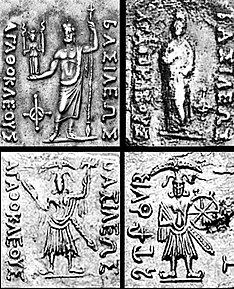
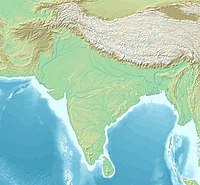
































![Detail of the Heliodorus pillar, with inscription in Brahmi by Heliodorus.[43]](https://upload.wikimedia.org/wikipedia/commons/thumb/5/5b/Heliodorus_pillar_inscription.jpg/66px-Heliodorus_pillar_inscription.jpg)


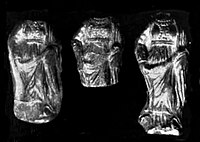
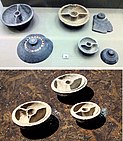


![An anguiped, also seen in Hellenistic and Roman art, Mathura art, c. 1st century BCE.[63]](https://upload.wikimedia.org/wikipedia/commons/thumb/f/f5/Vyala_Yaksha_-_Circa_1st_Century_BCE_-_ACCN_42-2944_-_Government_Museum_-_Mathura_2013-02-24_6175.JPG/80px-Vyala_Yaksha_-_Circa_1st_Century_BCE_-_ACCN_42-2944_-_Government_Museum_-_Mathura_2013-02-24_6175.JPG)

